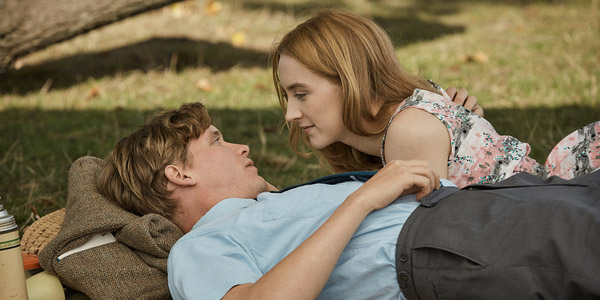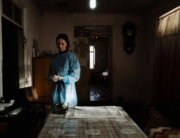Perhaps the only one who would be up to the challenge of adapting Ian McEwan’s elegant and acerbic 2007 novella On Chesil Beach is none other than the author himself. (His introspective, free-flowing, observational prose is an effortless afternoon read, and a different sort of social novel.) But in fleshing out the characters and expanding his story line, he raises more than a few questions that contradict his own source material.
The film, which world premiered at the Toronto International Film Festival, opens in 1962 England, during the life changing honeymoon of Edward (Billy Howle) and Florence (Saoirse Ronan). The filmmakers deploy every trick—a sound cue, an intrusive memory, a gesture, you name it—to trigger flashbacks into the recent pasts of both newlyweds and their above-the-board courtship.
It’s roughly around the middle of the film that we see how they first met. On the same day that he receives news that he has placed first in history at the University College London, Edward Mayhew, on a lark, goes on a jaunt to nearby Oxford and crashes a ban-the-bomb meeting, where the then-Florence Ponting fixes eyes on him immediately—a violinist, she placed first, at Oxford. A fan of the Soho jazz scene, Edward is smitten and bemused by Florence. He realizes early on that, in his words, she’s “the squarest person in all of Western Civilization.” He just has no idea how much so.
Florence’s mother (Emily Watson) sneers that UCL is the school for sons of tradesman. Florence, though, finds Edward is not like anyone else she knows, and she also becomes accepted into his lower-middle-class family, particularly when she gently deals with his mother, Marjorie (Anne-Marie Duff), who was brain damaged in an accident. (As is the wont in portraying those with mental disabilities in movies, Marjorie often strips off her clothes.) Florence becomes helpful to Edward and his mother; she’s quite empathetic, a quality that might make her later decisions a bit perplexing.
Unlike in the novel, there’s no mention that had the couple been just a little bit younger, they would have come of age during the Swinging Sixties, after the arrival of the Beatles and the birth control pill, and their circumstances may have been entirely different. Neither Edward nor Florence, both 22-year-old virgins, has any inkling, emotionally or physically, what’s in store on the wedding night, which the filmmakers depict like a car wreck in slow motion, gingerly building up to rumpling the bed sheets. (As played by Ronan, Florence is amused by her new halting husband’s awkwardness in front of the hotel staff, but as originally written by McEwan, she’s terrified of the night to come.)
Some of the exposition evolves through the conversations in the couple’s honeymoon suite, a delaying tactic on Florence’s part, making what will occur a little problematic. After all, the couple’s dialogue becomes something like a confessional for them both; the young husband and wife probably know more about each other than most couples—even after the let-it-all-hang-out 1970s—so the roadblock that hits their relationship comes across as a little bit more out of left field and more, ahem, penetrable than it should be.
One refreshing change from novel to screen is that the interplay and fallout between the honeymooners is more balanced by the delicate direction of Dominic Cooke, in his feature film debut. (He was one of the directors of TV’s The Hollow Crown: The War of the Roses.) Neither newlywed is completely at fault for what happens. On the page, Florence definitely comes across as more withholding and less forthcoming and willing to compromise.
Additionally, though this is a Britain that is still weaning itself away from the postwar years, the production design is a welcome departure for a mid-20th-century period piece. The color palette is full of light blues and greens, as opposed to the stereotypical grays and browns that usually signal some form of repression. The sun actually shines.
The film, however, lessens the extremity of Florence’s actions by insinuating a justification for her wedding-night jitters (not to give too much away). This may satisfy viewers who want more solid motivations, but it makes the story, and Florence, less enigmatic. Likewise, the movie’s tear-filled and groan-inducing ending has more finality than the book’s lingering and melancholic speculation. And any movie risks audience detachment when the characters suddenly age and the actors wear off-putting old-age make-up, but at least viewers will know who Ronan will look like decades from now: Helen Mirren.







Leave A Comment